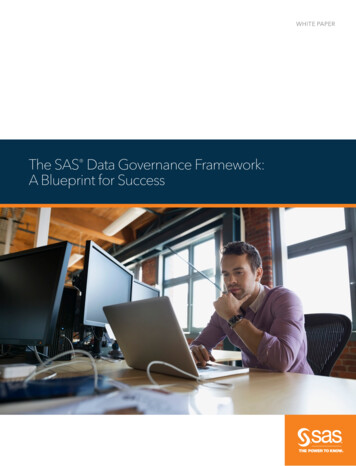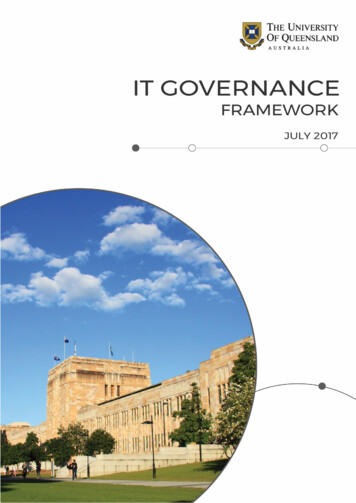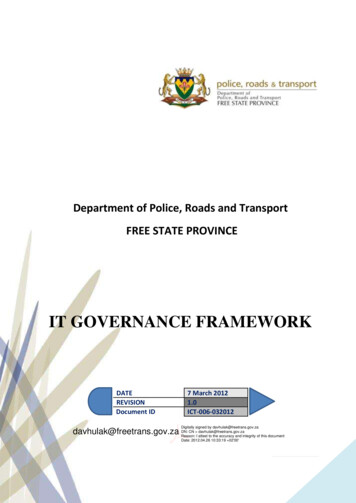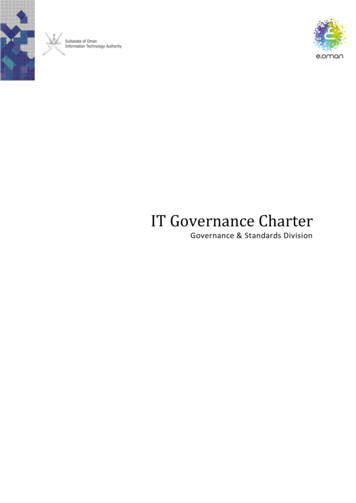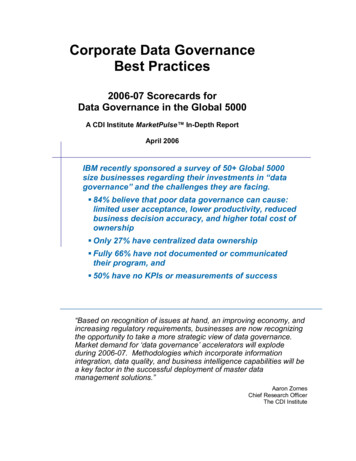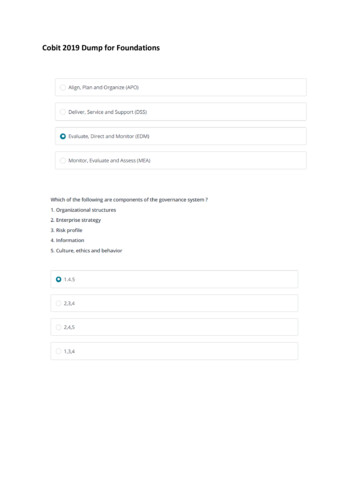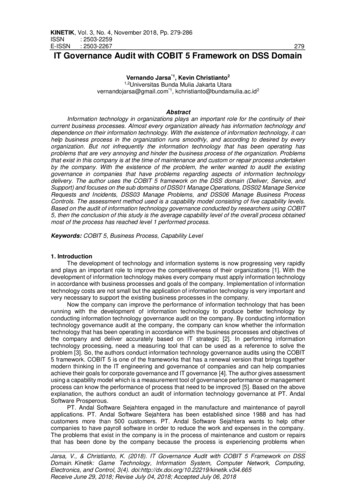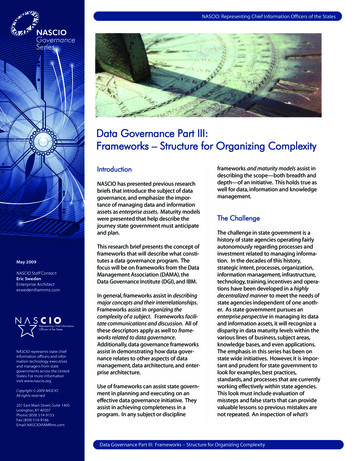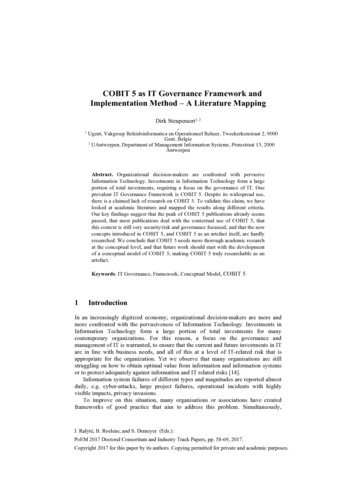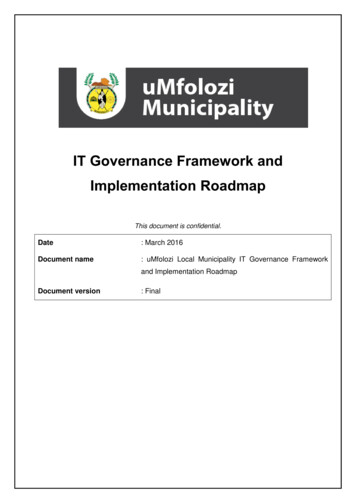
Transcription
IT Governance Framework andImplementation RoadmapThis document is confidential.Date: March 2016Document name: uMfolozi Local Municipality IT Governance Frameworkand Implementation RoadmapDocument version: Final
Document ControlDocumentInformationInformationDocument IdDocument OwnerIssue DateDocumentVersion[1.0]HistoryIssue Date[Date]Changes[Section, Page(s) and Text Revised]01/03/2016ReviewuMfolozi IT Governance FrameworkPage 2 of22
Table of Contents1. Introduction . 42. Executive Summary . 53. Background to IT Governance . 74. Approach . 95. Approach .Error! Bookmark not defined.6. COBIT Heat map . 167. IT Priority Roadmap . 168. Priority 1 Enablers . 169. Priority Roadmap . 1710.Mapping the IT Governance Framework to KING III . 1811.uMfolozi Municipality Role Mappings . 21uMfolozi IT Governance FrameworkPage 3 of22
1.IntroductionA need for a well governed IT function is becoming more apparent as businessleaders are forced to critically evaluate their cost and value chains in challengingeconomic environments. Additionally, their compliance, audit, risk and securityenvironments are becoming the focus of attention in a world where regulatorycompliance can fundamentally impair or enable the operations of a company,whether in the private sector or in government.uMfolozi IT Governance FrameworkPage 4 of22
2.Executive SummaryA need for a well governed IT function is becoming more apparent as businessleaders are forced to critically evaluate their cost and value chains in challengingeconomic environments. Globally, enterprises—whether public or private, large orsmall—increasingly understand that information is a key resource and that IT is astrategic asset and important contributor to success. Additionally, their compliance,audit, risk and security environments are becoming the focus of attention in a worldwhere regulatory compliance can fundamentally impair or enable the operations of abusiness.uMfolozi Local Municipality, with the assistance of AdvisoryIT, have formed acustomised IT Governance Framework and implementation roadmap focussing onthe governance of the IT function across uMfolozi . This governance framework isbroken into major components, namely the IT goals based on business priorities, theprioritised IT Governance Framework, the IT Governance implementation roadmapand the IT Governance task list.The IT Governance Framework takes into account both the risk mitigation andperformance considerations required to create a complete IT governance overview.The COBIT framework has been utilised to provide the basis for the IT GovernanceFramework. COBIT focuses on implementing governance within IT, controlling ITand monitoring the performance of IT. An understanding of the uMfolozi stakeholderneeds was sort followed by an assessment based on the Kaplan-Norton BalancedScorecard to determine the key priorities of the municipality. These were then usedto extract the associated key IT goals, used to define the required performanceelements of the IT Governance Framework. Finally, an implementation roadmap forthe governance framework was formulated based on the input from the IT Strategydevelopment Architecture workshops and risk and performance workshops with theIT Manager. This approach ensures that this IT Governance Framework andimplementation roadmap has been formed to include the relevant areas for uMfolozifrom the industry accepted IT governance agendas.uMfolozi IT Governance FrameworkPage 5 of22
Numerous supporting sheets are provided to interpret the IT Governance definitions,governanceimplementation task lists, proposed implementation timelines and dependencies, aswell as guidance on how the framework and roadmap is to be used.uMfolozi IT Governance FrameworkPage 6 of22
3. Background to IT GovernanceA need for a well governed IT function is becoming more apparent as businessleaders are forced to critically evaluate their cost and value chains in challengingeconomic environments. Globally, enterprises—whether public or private, large orsmall—increasingly understand that information is a key resource and that IT is astrategic asset and important contributor to success. Additionally, their compliance,audit, risk and security environments are becoming the focus of attention in a worldwhere regulatory compliance can fundamentally impair or enable the operations of abusiness.Governance of Enterprise IT ("GEIT") is a subset discipline of Corporate Governancefocused on Information Technology as a resource and their risk and performancemanagement. The rising interest in IT Governance is partly due to complianceinitiatives, for instance Sarbanes-Oxley in the USA, Basel II in Europe and King III inSouth Africa, as well as the acknowledgement that IT investments can easily get outof control and profoundly affect the performance of an organisation.Successful enterprises have recognised that the board and executives need toembrace IT like any other significant part of doing business. Boards andmanagement—both in the business and IT functions—must collaborate and worktogether, so that IT is included within the governance and management approach.The traditional involvement of board-level executives in IT issues was to defer all keydecisions to the company's IT professionals. IT Governance implies a system inwhich all stakeholders, including the board, internal customers, and in particulardepartments such as finance, have the necessary input into the decision makingprocess. This prevents IT from independently making and later being held solelyresponsible for poor decisions. It also prevents critical users from later finding thatthe system does not behave or perform as expected.The discipline of GEIT is supported by a number of reference frameworks to guide itsimplementation. Of these probably the most prominent are Control Objectives forInformation and related Technology ("COBIT"), the IT Infrastructure Library ("ITIL")uMfolozi IT Governance FrameworkPage 7 of22
and ISO27001 (previously ISO17799). GEIT, like Corporate Governance, is aframework that is implemented to support a business. Since no two businesses areexactly alike, it stands to reason that their governance frameworks would need to becatered to the specific resource, risk and performance environment that they operatein. As such, reference frameworks should not be taken as verbatim implementationtemplates for an organisation, but rather as starting points for a guided discussion onthe best governance framework for the organisation.uMfolozi IT Governance FrameworkPage 8 of22
4. ApproachThe IT Governance Framework helps enterprises create optimal value from IT bymaintaining a balance between realising benefits and optimising risk levels andresource use. The COBIT framework (version 5.0) has been utilised to provide thebasis for the IT Governance Framework. COBIT enables IT to be governed andmanaged in a holistic manner for the entire enterprise, taking in the full end-to-endbusiness and IT functional areas of responsibility, considering the IT-related interestsof internal and external stakeholders. The outcome of the Enterprise Architectureworkshops performed as part of the IT Strategy development was used as input tounderstand the municipality's value chain and priorities.An understanding of the uMfolozi stakeholder needs was followed by an assessmentbased on the Kaplan-Norton Balanced Scorecard to determine the key priorities ofthe municipality. These were then used to extract the associated key IT goals, usedto define the required performance elements (enablers) of the IT GovernanceFramework. Finally, an implementation roadmap for the governance framework wasformulated based on the risk and performance workshops with the IT Manager. Thisapproach ensured that this IT Governance Framework and implementation roadmaphas been formed to include the relevant areas for uMfolozi from the industryaccepted IT Governance agendas.uMfolozi IT Governance FrameworkPage 9 of22
The diagram below depicts the general process followed in order to arrive at the ITGovernance Framework and implementation roadmap: Below is an itemisedbreakdown of the steps taken to form the IT Governance Framework, roadmap andpriority 1 task list.1. edwiththePerformance manager responsible for the IDP and its execution and the ITmanager to confirm the stakeholder values from interpretation of the IDP.2. A review of the results of the Architecture workshops performed as part of thedevelopment of an IT Strategy was performed to understand the businesspriorities for uMfoloziuMfolozi IT Governance FrameworkPage 10 of22
3. A review of the risk register and IT audit reports and discussions with the ITmanager was performed to understand the risks and controls faced by uMfolozi4. A business priority workshop was performed with the Performance managerresponsible for the IDP and its execution and the IT manager to confirm keybusiness goals of uMfolozi from interpretation of the IDP, based on the KaplanNorton Balanced Scorecard.5. The key municipality goals were linked to their related IT goals. These IT goalswere then matched to their required COBIT enablers.6. A COBIT process "heat map" was formed based on IT goals, supplemented withareas identified from analysing the IDPs, IT audit reports, risk register, uMfoloziArchitecture documentation and general good practice. This heat map was usedto identify the priority 1, 2 and 3 IT Governance areas for the municipality7. A workshop was held with IT to identify key documents and the related task listfor priority 1 areasuMfolozi IT Governance FrameworkPage 11 of22
5. COBIT 5 OverviewInformation is a key resource for all enterprises, and from the time that information iscreated to the moment that it is destroyed, technology plays a significant role.Successful enterprises have recognised that the board and executives need toembrace IT like any other significant part of doing business. COBIT 5 provides acomprehensive framework that assists enterprises in achieving their objectives forthe governance and management of enterprise IT. Simply stated, it helps enterprisescreate optimal value from IT by maintaining a balance between realising benefits andoptimising risk levels and resource use. COBIT 5 enables IT to be governed andmanaged in a holistic manner for the entire enterprise, taking in the full end-to-endbusiness and IT functional areas of responsibility, considering the IT-related interestsof internal and external stakeholders.COBIT 5 is based on five key principles for governance and management ofenterprise IT detailed below. Together, these principles enable the enterprise to buildan effective governance and management framework that optimises information andtechnology investment and use for the benefit of stakeholders.uMfolozi IT Governance FrameworkPage 12 of22
Principle 1: Meeting Stakeholder Needs:Enterprises exist to create value for their stakeholders by maintaining a balancebetween the realisation of benefits and the optimisation of risk and use of resources.COBIT 5 provides all of the required processes and other enablers to supportbusiness value creation through the use of IT. Because every enterprise hasdifferent objectives, an enterprise can customise COBIT 5 to suit its own contextthrough the goals cascade, translating high-level enterprise goals into manageable,specific, IT-related goals and mapping these to specific processes and practices.Principle 2: Covering the Enterprise End-to-end:COBIT 5 integrates governance of enterprise IT into enterprise governance: It covers all functions and processes within the enterprise; COBIT 5 does notfocus only on the ‘IT function’, but treats information and related technologiesas assets that need to be dealt with just like any other asset by everyone inthe enterprise. It considers all IT-related governance and management enablers to beenterprise wide and end-to-end, i.e., inclusive of everything and everyone—internal and external—that is relevant to governance and management ofenterprise information and related IT.Principle 3: Applying a Single, Integrated Framework:There are many IT-related standards and best practices, each providing guidance ona subset of IT activities. COBIT 5 aligns with other relevant standards andframeworks at a high level, and thus can serve as the overarching framework forgovernance and management of enterprise IT.Principle 4: Enabling a Holistic Approach:Efficient and effective governance and management of enterprise IT require aholistic approach, taking into account several interacting components. COBIT 5defines a set of enablers to support the implementation of a comprehensivegovernance and management system for enterprise IT. Enablers are broadly definedas anything that can help to achieve the objectives of the enterprise. The COBIT 5uMfolozi IT Governance FrameworkPage 13 of22
framework defines seven categories of enablers namely: Principles, Policies andFrameworks; Processes; Organisational Structures; Culture, Ethics and plication,People,SkillsandCompetencies.Principle 5: Separating Governance:From Management—The COBIT 5 framework makes a clear distinction betweengovernance and management. These two disciplines encompass different types ofactivities, require different organisational structures and serve different purposes.COBIT 5’s view on this key distinction between governance and management is: Governance ensures that stakeholder needs, conditions and options areevaluated to determine balanced, agreed-on enterprise objectives to beachieved; setting direction through prioritisation and decision making; andmonitoring performance and compliance against agreed-on direction andobjectives. In most enterprises, overall governance is the responsibility of theboard of directors under the leadership of the chairperson. Specificgovernance responsibilities may be delegated to special organisationalstructures at an appropriate level, particularly in larger, complex enterprises. Management plans, builds, runs and monitors activities in alignment with thedirection set by the governance body to achieve the enterprise objectives. Inmost enterprises, management is the responsibility of the executivemanagement under the leadership of the chief executive officer (CEO).COBIT 5 - Process Reference ModelCOBIT 5 includes a process reference model, which defines and describes in detaila number of governance and management processes. It represents all of theprocesses normally found in an enterprise relating to IT activities, providing commonreference model understandable to operational IT and business managers. Aprocess is one of the seven enablers and COBIT is in the process of creating modelsfor the other enablers. In this IT Governance Framework, processes were used as abaseline and the other enablers where taken into account where relevant under theIT related processes identified to be relevant for iLembe to meet its Enterprise goals.uMfolozi IT Governance FrameworkPage 14 of22
The figure below shows the complete set of 37 governance and managementprocesses within COBIT 5. The details of all processes, according to the processmodel described previously, are included in a guide entitled COBIT 5: EnablingProcesses.uMfolozi IT Governance FrameworkPage 15 of22
6. COBIT Heat mapAPPENDIX A - Business Priorities to IT Goals Results - COBIT Heat map link.uMfolozi ITGovernance Framework.xlsx7. IT Priority RoadmapAPPENDIX B – IT Priority Roadmap.uMfolozi ITGovernance Framework.xlsx8. Priority 1 EnablersAPPENDIX C - Priority 1Enablers for the Organisation.uMfolozi ITGovernance Framework.xlsxuMfolozi IT Governance FrameworkPage 16 of22
9. Priority RoadmapuMfolozi IT Governance FrameworkPage 17 of22
10.Mapping the IT Governance Framework to KING IIIOf particular reference to the development of an IT Governance Framework isChapter 5 of the King III Code on Corporate Governance which sets forth sevenguiding principles for IT Governance. Those recommended practices supporting theprinciples which are specifically addressed by the contents of the IT GovernanceFramework are marked with a P . - Denotes elements of the IT GovernanceFramework that contribute partially to alignment with the King III recommendedpractices. The respective section of the framework addressing KING III areas isspecified under 'Section'.Principle 1: Board responsibilityRecommended practicesIndicatorThe Board should assume the responsibility for thegovernance of IT and place it on the board agenda.The Board should ensure that an IT charter and policiesare established and implemented.The Board should ensure promotion of an ethical ITgovernance culture and awareness and of a common ITSectionEDM01PP-APO01EDM01.02language.The Board should receive independent assurance on theNoteffectiveness of the IT internal controls.addressedThe Board should receive independent assurance on theeffectiveness of the IT internal controls.uMfolozi IT Governance Framework-beingMEA03.03Page 18 of22
Principle 2: Performance and SustainabilityRecommended practicesIndicatorSectionThe Board should ensure that the IT strategy isAPO02integrated with the company’s strategic and businessPprocesses.The Board should ensure that there is a process inBAI02place to identify and exploit opportunities to improvethe performance and sustainability of the company-through the use of ITPrinciple 3: IT Governance FrameworkRecommended onEDM01Pmechanisms for the IT Governance Framework.The Board may appoint an IT steering committee orsimilar function to assist with its governance of IT.APO01PThe CEO should appoint a Chief Information Officerresponsible for the management of IT.APO01PThe CIO should be a suitably qualified and experiencedperson who should have access and interact regularly onAPO01.05-strategic IT matters with the board and/or appropriateboard committee and executive management.uMfolozi IT Governance FrameworkPage 19 of22
Principle 4: IT InvestmentsRecommended practicesIndicatorThe Board should oversee the value delivery of IT andmonitor the return on investment from significant ITSectionAPO05.03-projects.The Board should ensure that intellectual propertyNotcontained in information systems are protectedapplicableThe Board should obtain independent assurance on theAPO10IT governance and controls supporting outsourced ITPservices.Note:It should be noted that some of the KING III IT Governance areas that are notindicated as covered above are already being addressed by the current uMfolozi ITprocessesuMfolozi IT Governance FrameworkPage 20 of22
11.uMfolozi Local Municipality Role MappingsCOBIT and uMfolozi Municipality define different roles within their respectiveframeworks. For a governance framework, it is essential to have aligned roles inorder to create, implement and monitor the Responsibility, Accountability, Consultedand Informed ("RACI") matrix. For the purpose of a complete governance framework,COBIT prescribed roles have been aligned with their overlying uMfolozi IT roles.Thus the role mappings should not be considered equivalent roles, but rather roleswhose responsibilities converge. In reality, however, the COBIT roles will be subsetsof the uMfolozi roles.COBIT 5 RolesuMfolozi IT RolesBoardCouncilCEOMunicipal ManagerCFOCFOCOOMunicipal ManagerBusiness ExecutivesDirectorsBusiness Process OwnersManagersStrategy Executive CommitteeExecutive CommitteeSteering(Programs/Projects) CommitteeIT Steering committeeProject Management officeIT ManagerValue management officeIT ManagerChief Risk OfficerRisk Management OfficerChief Information Security OfficerIT ManagerArchitecture BoardIT Steering CommitteeEnterprise Risk CommitteeMANCO Risk CommitteeHead Human ResourcesHuman Resources ManagerComplianceInternal AuditAuditInternal AuditChief Information OfficerDirector Corporate ServicesHead ArchitectIT ManagerHead DevelopmentIT ManageruMfolozi IT Governance FrameworkPage 21 of22
COBIT 5 RolesuMfolozi IT RolesHead IT OperationsSystems AdministratorHead IT AdministrationSystems AdministratorService ManagerICT Security OfficerInformation Security ManagerICT Security OfficerBusiness Continuity ManagerManager: Disaster ManagementPrivacy OfficerICT Security OfficeruMfolozi IT Governance FrameworkPage 22 of22
The COBIT framework (version 5.0) has been utilised to provide the basis for the IT Governance Framework. COBIT enables IT to be governed and managed in a holistic manner for the entire enterprise, taking in the full end-to-end business and IT functional areas of responsibility, considering the IT-related interests .
